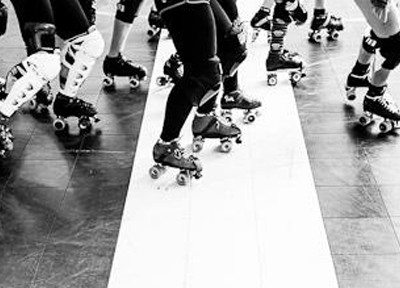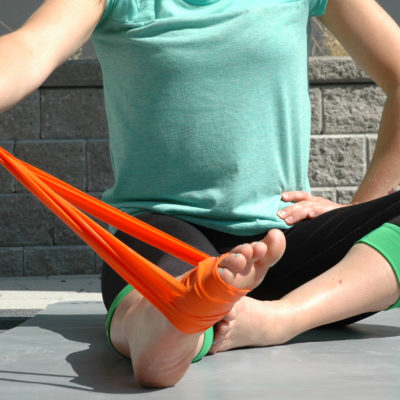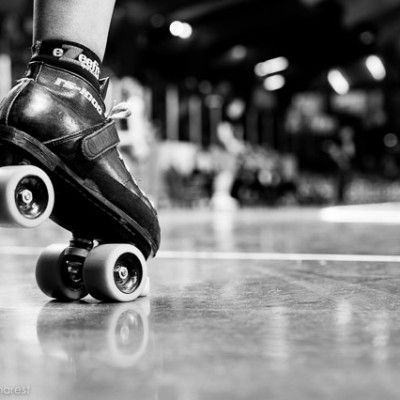
Despite our helmets and our mouthguards, concussions are among the most frequent, and most traumatic of roller derby injuries.
Anyone who’s suffered a concussion in derby can tell you how crappy the experience can be, on many levels. From the initial, acute stages where you feel just awful, to the later stages where your cognitive abilities and emotions can remain altered for weeks and even months – it’s no damn fun, people!
Your brain is your brain, and you’ve only got one, so I’m here with some Pre-Hab exercises that can actually help reduce the frequency and severity of concussions.
What? You didn’t think there was an exercise that could help save your melon? Seems farfetched, but our counterparts in the professional sports have actually figured this out. Hockey and football players are beginning to work this stuff in to their training routines nowadays, based on some promising research and studies, including the oft-cited report by Prof. Dawn Comstock et al on concussions in youth sports.[1]
Comstock’s study “found that for every one-pound increase in neck strength, the chances of sustaining head trauma fell by 5 percent.”[2]
FIVE percent reduced chances, for every ONE pound of strength gain? I will TAKE those odds!
The study (based on high school sports) also shows that girls are more susceptible than boys to concussions, and speculates that smaller neck circumferences (e.g. weaker neck muscles) with the same helmet sizes and weights may contribute.
Basically, if your noggin’ looks like an orange riding a toothpick (thanks, Mike Meyers), you may be more susceptible than someone who looks a little more like a no-neck thug. But we can probably find a happy medium with these simple concussion avoidance exercises I’m about to show you!
Listen up! If you play roller derby, and you value your brain, you should be doing neck strengthening. So true, you should probably tweet that right now.
Here’s the drill:
You need: one head, two hands, a pair of matching weights (see below for suggestions), and a 6″ to 8″ diameter soft ball.
Part One: Isometric contractions, pressing against your hand: forward, backward, rotate R/L, ear to shoulder R/L, and forehead forward & up. Hold each one for a count of 5 to 8. Repeat 3 to 5 times each.
Part Two: Weighted exercises: Shrugs, vertical rows, and overhead presses. For simplicity’s sake, I’ll break the reps and weight down into three categories:
- Skates as weights: at a minimum, do 1 set of 20 reps of each. For better results, do three sets of 20.
- Milk jugs as weights (ahem, full ones!) = roughly 8.8 lbs each or 4kg each. Do 2 or 3 sets of 15-20 each.
- Dumbbells: Start at 12-15 pound dumbbells, or where you feel comfortable. Try 2 or 3 sets of 15 each. To really improve, increase your weight to where each exercise feels *extremely* difficult/impossible by rep 20 (shrugs), 12 (rows), and 10 (presses).
Part Three: Ball rolling: Spend 30s rolling lightly in each position: front, left side, right side, back. You could use a toy store ball as I did, a pilates-type ball, or a slightly deflated volleyball.Use a smaller, softer ball and increase the difficulty by a) moving feet further from the wall while remaining in a planked body/neck position, b) inflating the ball more, and c) increasing the size of the ball. Progress to a small physio ball (aka stability ball, swiss ball).
Please remember that important note I made in the video – avoid jutting your chin out while doing any of these exercises. Aim to keep a bit of a double chin going throughout your neck strengthening, to protect your cervical spine.
You don’t need to do all three parts of this routine in order, or even at the same time. I like to do the isometrics before every practice as it “wakes up” my super-weak post-whiplash muscles and reminds them to do their job when I take a hit. The others I do at the gym or in front of the TV.
Here’s one last really important point I want to make ultra clear. Did you notice that nowhere in this article or the video did I say “prevent” concussions? It’s true. Let’s be honest – we can’t ever promise to prevent an injury. But we can reduce our chances, and reduce the severity of a likely injury. And I like those odds.
xo Booty Quake
Pssst: Make sure you also check out my article on Safely Returning to Roller Derby After a Concussion!
[email_signup]
References:
1. Marar, Mallika, BS McIlvain, Natalie, JD, PhD Fields, Sarah, Ph D.Comstock, Dawn, “Epidemiology of Concussions Among High School Athletes in 20 Sports.” AJSM PreView, published January 27, 2012
2. Torres, Ben, “Can Neck Strength Reduce Concussions in Women’s Soccer?” Stack.com, posted April 9, 2014. http://www.stack.com/2014/04/09/girls-soccer-concussions/
3. Gregory, Sean, “Neck Strength Predicts Concussion Risk, Study Says.” Time.com, posted February 21, 2013. http://keepingscore.blogs.time.com/2013/02/21/study-neck-strength-predicts-concussion-risk/

 Stop sucking. Start winning.
Stop sucking. Start winning.  Prehab! Feet and Ankles
Prehab! Feet and Ankles  Cross-Training for Roller Derby: A Primer
Cross-Training for Roller Derby: A Primer  Go From Benchwarmer to MVP with the 1% Secret
Go From Benchwarmer to MVP with the 1% Secret  PreHab: How to Reduce Concussions
PreHab: How to Reduce Concussions
Hey Booty!
First, I want to say that I love that you’re covering this. It’s taken a while for derby to start taking head injuries seriously. Thankfully, every time someone skaters look up to talks about it, especially when armed with real research, the word spreads High five!
Second, I appreciate that you worked to avoid the words “prevent” or “cure.” People tend to throw those words around, and, as athletes, any time someone says we can prevent something by doing some exercises, we’re probably going to do them. Hopefully, at least. Unfortunately, given the nature of how concussions work, you can’t prevent them, only reduce your risk of getting them. No magic exercise, helmet, or mouthguard will completely protect you from a head injury. The word “prevention” did show up in “concussion prevention exercises” – is there a better name?
Kudos again, and thanks for helping us take head injuries more seriously and for giving us things we can do to help ourselves!
-Highney
Thanks for the thoughtful note, Highney! Darn, so I let a “concussion prevention” slip in there, did I? I guess it rolls off the tongue a lot better than concussion reduction exercise… Hopefully the intent is understood. :)
These are very good exercises to do :) I used to coach highly competitive amateur Boxing , and all of the boxers did these as part of our warm ups :)
Arnold
Good to hear, Arnold! I know wrestlers do a lot of serious neck strengthening too. I’m all about learning from other sports!
Oh how I wish I had read & used this article before I had my concussion/whiplash. I can’t begin to describe what I went through and how long recovery took. Plus I had a couple of re-injuries before I healed completely. I still have trouble, and pinched nerves. I will definitely be trying these exercises! Anything else you can share would be greatly appreciated! Thank you!!
I suffered a concussion 15 mins into a bout last year. Elbow to the face. It was awful and all I’ve seen are the worst case sinarios about concussions and getting more than one. This has regained my hope that I can do something to again lower my risk. I will be doing these at least 3 days a week. Thank you so much. If the thread is still going I will give feedback in a year :)
Oh dear, that sounds awful, Grimmy! Neck strengthening may not protect you from another direct blow to the head, but at least it will help with the more prevalent incident which is the helmet hitting the track scenario. Good luck with your training!